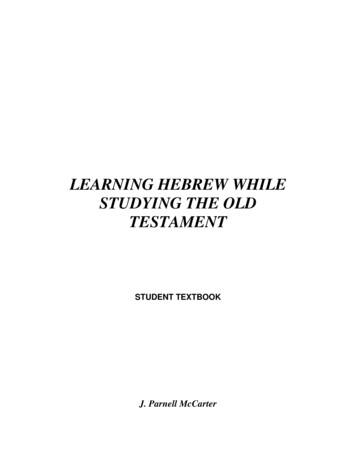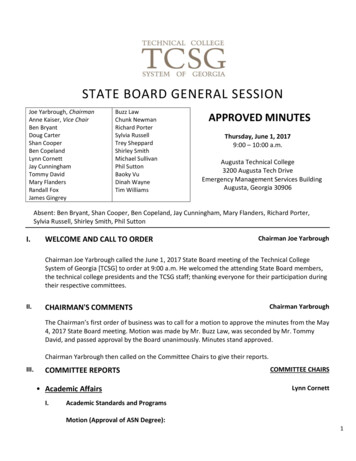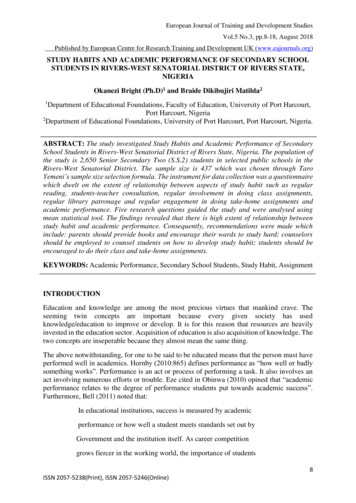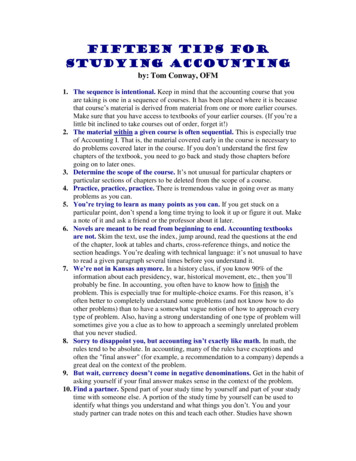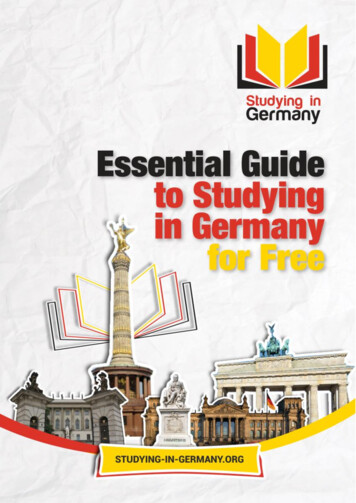
Transcription
“Start” the year by studying “The End”The Book of Revelation8 Week StudyBegins Wednesday, Jan. 10, 2018, 7pmTaught by Dr. Joshua BeckleyUpdated: 3/4/2018Click on the page numbers you want to see.Print all or just the range of pages you want to print8 Week Study ScheduleJan. 10Intro and Rev. 1Jan. 17Rev. 2:1-7Jan. 24Rev. 2:8-11Jan. 31Rev. 2:12-17Feb. 7Rev. 2:18-29Feb. 21Rev. 3:1-6Feb. 28Rev. 3:7-13Mar. 7Rev. disPhiladephiaLaodiceaPages to Print1-67-1011-1516-1920-2324-2728-3132-35
A Map of the Area2
Keys to Understanding the Book of RevelationLies of the devil:Revelation is too “scary” Revelation is too hard to understand Revelation is not for me Truth of God:Revelation is a book of WorshipRevelation presents clearest picture of our Glorious Resurrected SaviorRevelation was written to “encourage” the saintsRevelation is the only New Testament book of prophecyRevelation depicts Christ riding “out of heaven to destroy sin and Satan and to restore creation to itsoriginal glory for our good and His good pleasure forever.” Chuck SwindollKey Verse:Revelation 1:19 provides a simple outline of entire book.“the things you have seen”Chapter 1“those that are”Chapters 2–3“those that are to take place after this”Chapters 4–22Key Divisions:Book of Revelation is understood in groups of “Seven”.Ch.1–3Seven Letters to Seven ChurchesCh. 4–6Seven SealsJudgments largely generated by the sinfulness of manCh. 7–9Seven TrumpetsJudgments largely associated with satanic and demonic activityCh. 10–13Seven SignsJudgments largely generated by the sinfulness of manCh. 14–16Seven Plagues/Bowls/VialsFinal series of judgments against those who followed the beast, just prior tothe return of ChristCh. 17–19Seven DoomsCh. 20–22Seven New Things3
Chapter 1 – January 10, 2018Introduction“Revelation” – Latin term revelatio, referring to: The act of revealing or making known The thing which is revealed In theology, designates God’s own self-disclosure or manifesting of himself, or thingsconcerning himself and the world May also mean the “Word” itself, oral or written, which bears such revelation Equivalent NT term: apocalypse means unveiling, uncovering, or making someone orsomething known Can also mean the “Word” itself which revealsTwo Kinds of Revelationa) General RevelationGod reveals himself in nature, in history, and in all people as made in his image.Ps.10:11; 14:1; 19:1; Acts 14:17; 17:22–29; Rom 1:19–21b) Special RevelationGod purposes to share his gracious, loving heart intending salvation of all people. Articulate language directly spoken (Gn 3:14–19; 6:13–21; 7:1–4; 12:1–3). Various means: Angel of the Lord (Gn 18:1–15)Burning bush (Ex 3:1–22)Cleft in the rock (Ex 34:6, 7)Fire and cloud (Ex 19) Came through dreams and visions (1 Sm 3:1–14). The zenith of God’s revelation was the coming in the flesh of his belovedSon, Jesus Christ (Jn 1:14–18; Gal 4:4, 5; Heb 1; 2). Jesus’ revelation of the Father and the Father’s gracious will toward allpeople was direct, accurate, and preeminent (Jn 14).Mankind would know nothing at all of God’s messianic purposes in Christ, had Godnot revealed his heart and purposes throughout Scripture.4
BackgroundWritten by the apostle John: Exile on the island of Patmos, off the coast of present-day Turkey.Letters from Christ himself to seven actual churches.Letters include commendation, criticism, and comfort.Then a long series of visions of judgment on the wicked, highly symbolic language.The Church is under great distress but assured of the final triumph of Jesus as “Kingof kings and Lord of lords” (19:16),Brings an end the rebellion of humanity and ushers in “a new heaven and a new earth”(21:1), where God himself will reign forever and ever (11:15).Revelation was probably written between A.D. 95–96.Prologue - Revelation 1:1-3 ESV1:1aPurpose of the Book1:1b-2Producer of the Book1:3Provision of the BookGreetings to the Seven Churches - Revelation 1:4-8 ESV1:4aThe Location of the Churches1:4b-6The Lord of the Churches1:6bThe Legacy of the Churches1:7-8The Legitimacy of the ChurchThe Vision of the Son of Man - Revelation 1:9-20 ESV1:9-11The Receiver of the Vision1:12-16The Revealed Vision1:17aThe Response to the Vision1:17b-20 The Reassurance from the VisionPERSONAL STUDY EXERCISE - COMPLETE BEFORE WEDNESDAY, JANUARY17.Study Instructions:1. Read Revelation 2:1-7 at least three times, meditate on these verses.2. After a time of meditation (thinking on the verses), use Bible resources if you like.3. Fill in the chart on the Church of Ephesus based on what the Lord teaches you.5
Personal Study for January 17, 2018Ephesus“The Loveless Church”2:1-7Who is being spoken to?2:1aDescribe the one who is speaking these words2:1bDescribe what the Speaker KNOWS (commendations)2:2-3, 2:6Describe what the Speaker SEES (concerns)2:4Describe what the Speaker COMMANDS2:5aDescribe what the Speaker CONCLUDES (consequences)2:5bDescribe what the Speaker STIPULATES (choices)2:7aDescribe what the Speaker REWARDS (promises)2:7b6
LESSON 2 – JANUARY 17, 2018Church of EphesusThe “Loveless” ChurchRevelation 2:1-7 ESVOverview Christ Commends the Ephesian Church for Its faithful practice Christ Condemns It for Its Lack of Witness Christ Exhorts It to Overcome This Lack in Order to Inherit Eternal LifeOutline of 2:1-71. ACKNOWLEDGED Work (vs. 2-3)"'I know your works."2. ABANDONED Work (vs. 4-5a)"But I have this against you, that you have abandoned the love you had at first."3. ATONING Work (v. 5b)"If not, I will come to you and remove your lampstand from its place, unless you repent."4. AGREED Work (v. 6)"Yet this you have: you hate the works of the Nicolaitans, which I also hate."About EPHESUS A port city of western Asia Minor at the mouth of the Cayster River. Ephesus lay between Smyrna and Miletus. Most important city of the Roman province of Asia, located on the western shore of AsiaMinor (modern Turkey). Ephesus was built on a natural harbor whose waves, according to the Roman writer Plinythe Elder, “used to wash up to the temple of Diana.” Ephesus was described by Strabo, an early Greek geographer, as the largest commercialcenter west of the Taurus Mountains. Well known as “guardian” of the temple of Artemis (Acts 19:34) [Romans called her, Diana].Christianity’s Threat Gospel threatened Pagan temple and the commerce it produced for the makers of idols. Preaching the Gospel almost cost the apostle Paul his life (Acts 19:24, 30–31). Associated with the early preaching in Ephesus:o Priscilla and Aquila (18:18–19)o Timothy (1 Tm 1:3)o Erastus (Acts 19:22) According to Irenaeus, an early Christian writer, apostle John, after his exile on the island ofPatmos (Rev 1:9), returned to live in Ephesus until time of emperor Trajan (AD 98–117). The commendable practices of the Christian community described in the letter to theEphesians had been largely abandoned by the time John wrote Revelation (Rev 2:4).City of Ephesus Founded by Ionian Greeks at a location where Cayster River emptied into Aegean Sea gulf. A city for about 1,000 years when Paul arrived on his third missionary journey (Acts 19). The worship of Artemis in Ephesus was as ancient as the city itself. The temple, built in middle of sixth century BC, was largest edifice in the Hellenistic world. The first of monumental size ever to be constructed entirely of marble.NICOLAITANS7
Heretical sect in the early churchMentioned by name twice in the book of Revelation:o Church at Ephesus was commended for hating the works of the Nicolaitans (2:6)o Church at Pergamum was criticized for having members who held their doctrine (2:15)Since the specific sins condemned at Pergamum—the eating of food sacrificed to idols andthe practice of immorality—were also present at Thyatira (Rev 2:20), it is commonly thoughtthat the woman Jezebel was a leader of the Nicolaitans in that church.In the letter to Pergamum, their sins are equated with the teaching of Balaam (Rev 2:14; cf.Num 25:1–2; 31:16; 2 Pet 2:15; Jude 1:11),o Balaam advised Balak, the king of the Moabites, to bring about Israel’s downfall byinviting them to worship the Moabite gods and engage in intermarriage and thesexual immoralities connected with Moabite religious practices.o Thus, the Jews would have been separated from God and his protection.o In Jewish thought, Balaam was the symbol of all that led men to obscene conduct andthe forsaking of God.o The ungodly practices at Thyatira are called the “deep things of Satan” (Rev 2:24).The Early Church Also Threatened By Idolatry and Immorality So Prevalent In The World The necessity for frequent warning in the NT reveals the gravity of the problem. The Jerusalem Council (Acts 15:20) called upon the Gentiles to abstain from eating food thathad been offered to idols and sexual immorality. Paul called for a voluntary avoidance of this kind of fare for the sake of those who wereweak or immature in the faith (1 Cor 8). He strongly condemned actual participation in:o Idol feasts (1 Cor 10:14–22)o fornication in generalo temple prostitution in particular (6:12–20)Who the Nicolaitans were is More Difficult to Determine The tendency among the church fathers was to identify them as followers of Nicolaus ofAntioch, a Gentile convert to the Jewish faith, who had become a Christian and was chosento be one of the original seven deacons (Acts 6:5). Both Irenaeus and Hippolytus believed that he had fallen from the faith. Clement claimed that the heretical and immoral Nicolaitans were not actual followers ofNicolaus but falsely claimed him as their teacher. In any event, there is no direct evidence available. Since the 19th century it has been common to view the name as a translation into Greek ofthe Hebrew name Balaam. This is in accord with the allegorical, symbolical nature of Revelation and the apparentlinking of the two names in the letter to Pergamum (Rev 2:14–15).8
LESSON 2 – JANUARY 17, 2018Church of EphesusThe “Loveless” ChurchRevelation 2:1-7 ESVBREAKOUT GROUP DISCUSSION QUESTIONS1. Read Acts 19:1-10; 19:21-41 and 20:17-37. Discuss the climate of Ephesus of the Churchand the city?2. At the time John writes this letter to the Church, what some of the reasons John saysthey have lost their first love?3. Think about your own spiritual journey, what areas of devotion in your life have slacked,since you first got saved?4. What do you think the Lord is saying to you about what you need to do to rekindle thatdevotion?5. Pray for one another concerning those areas that need rekindling.PERSONAL STUDY EXERCISE - COMPLETE BEFORE WEDNESDAY, JANUARY24.Study Instructions:1. Read Revelation 2:8-11 at least three times, meditate on these verses.2. After a time of meditation (thinking on the verses), use Bible resources if you like.3. Fill in the chart on the Church of Smyrna based on what the Lord teaches you.9
Personal Study for January 24, 2018Smyrna“The Persecuted Church”2:8-11Who is being spoken to?2:8aDescribe the one who is speaking these words2:8bDescribe what the Speaker KNOWS (commendations)2:9aDescribe what the Speaker SEES (concerns)2:9bDescribe what the Speaker COMMANDS2:10a, 2:10cDescribe what the Speaker CONCLUDES (consequences)N/ADescribe what the Speaker STIPULATES (choices)2:11aDescribe what the Speaker REWARDS (promises)2:11b10
LESSON 3 – JANUARY 24, 2018Church of Smyrna (Myrrh)The “Persecuted” ChurchRevelation 2:8-11 ESVOverview Christ commends the Church of Smyrna for enduring tribulation Christ encourages the Church of Smyrna to continue to be faithful in anticipation ofimminent, more severe persecution, in order to inherit eternal life and heavenly kingshipAbout Myrrh First mentioned as a principal ingredient in the holy anointing oil (Ex. 30:23). Gift brought by the wise men from the east, who came to worship infant Jesus (Matt. 2:11). It was used in embalming (John 19:39), It was also used as a perfume (Esther 2:12; Ps. 45:8; Prov. 7:17). Custom of the Jews to give those condemned to death by crucifixion “wine mingled withmyrrh” to produce insensibility.o This drugged wine was probably partaken of by the two malefactorso But when the Roman soldiers pressed it upon Jesus “he received it not” (Mark 15:23)About SMYRNA (Rev 1:11; 2:8–11) It is the modern Izmir, located in Turkey. Inhabited at least 3,000 years before Christ. The Aeolian Greeks were replaced by the Ionians. The city, along with Miletus and Ephesus to the south, flourished under Ionian dominance.o Ionians were one of four major tribes the Greeks divided into during ancient period.o The other three being the Dorians, Aeolians, and Achaeans.[1] Ionian dialect (and Dorian and Aeolian) the three major linguistic divisions of Hellenic world “Ionian” defines several groups in Classical Greece:o In the narrowest sense, referred to the region of Ionia in Asia Minor.o In a broader sense, described all speakers of Ionic dialect (Ionia proper also includedpopulations of Euboea, the Cyclades, and many cities founded by Ionian colonists.o In the broadest sense, described all those who spoke languages of the EastGreek group, which included Attic.The city was conquered by the Lydians whose capital was Sardis The Lydians were an Anatolian people living in Lydia, a region in western Anatolia, whospoke the distinctive Lydian language, an Indo-European language of the Anatolian group. The site was left in ruins for nearly three centuries until its re-founding by Alexander theGreat in 334 BC at a site farther south along the gulf. Although built by the energy of the Seleucids, the city recognized the coming dominance ofPergamum and entered into an alliance with its king. Later, with remarkable foresight, she transferred her allegiance to Rome, and in 195 BC builta temple in which Rome was worshiped as a deity. Reward for Smyrna’s early commitment to rising Roman influence, the city prospered underRoman rule, partly as a rival to Pergamum and partly as a rival to prosperous island of Rhodes. Because they had been an ally of the Romans, the people of Smyrna thought it would be totheir credit to build (in AD 26) a temple in which the Roman emperor would be honored. This city became the seat of the Caesar cult that afflicted the church so seriously during thelatter half of the first century.Historical Timeline11
The Seleucid era or Anno Graecorum (literally "year of the Greeks" or "Greek year"),sometimes denoted "AG", was a system of numbering years in use by the SeleucidEmpire and other countries among the ancient Hellenistic civilizations.It is sometimes referred to as "the dominion of the Seleucidæ," or the Year of Alexander.The era dates from Seleucus I Nicator's re-conquest of Babylon in 312/11 BC after his exilein Ptolemaic Egypt,[1] considered by Seleucus and his court to mark the founding of theSeleucid Empire.According to Jewish Tradition, it was during the sixth year of Alexander the Great's reign(possibly Alexander the Great's infant son, Alexander IV of Macedon) that they began tomake use of this counting.[2]The introduction of the new era is mentioned in one of the Babylonian Chronicles, theChronicle of the Diadochi.Revelation 2:8 speaks of the city as being “dead and then alive” A possible allusion to the period of 300 years when it lay devastated until revived byAlexander and the Macedonians. Ancient writers (Appollonius and Aristides) spoke of Smyrna as having the “crown of life.” This was a way of describing the hilltop behind the city as if it crowned Smyrna on top, withits feet at the seashore, known as “the Crown of Smyra.” The promise of “the crown of life” to the Smyrnean believers probably plays off this image. This promise was given to believers in Smyrna who would remain faithful through persecution.References to “synagogue of Satan” (Rev 2:9) and to the devil putting them in prison (Rev 2:10) Reflects the tribulation probably experienced under Roman emperor Domitian (c. AD 95). Crime punishable by death to refuse to worship the image of the Roman emperor as “lord.” Many Christians were compelled to choose between “Caesar as Lord” or “Jesus as Lord.” To choose Jesus was to choose martyrdom.SYNAGOGUE OF SATAN A reference to Jewish persecutors of the Church (Rev 2:9; 3:9). Members of the “synagogue of Satan” were persecuting churches of Smyrna and Philadelphia. In Revelation, Jesus denounces them despite their claims to Judaism and the synagogue. May also refer to Christians who sought protection from the synagogue during times of difficulty.IRONIC Jews’ attack against Smyrnean church demonstrated that Jews were not only “false Jews”but also “a synagogue of Satan,” and that the church, by implication, was the “true Israel.” Some commentators demur on the identification of the church with latter-day Israel. Nevertheless, the identification is confirmed not only by broad contextual indicators (e.g.,1:6, 7, 9, 12; 2:17; 3:9, 12; 5:9–10; 7:4–9, 15–17; 11:1–4) but also by the fact that in theimmediate context the church is seen as fulfilling Isaiah’s prophecy about Israel. Identification is enhanced by association of the church’s trial with Daniel and his friends (2:10). The false accusations against the saints that induced oppression identify the Jews with“satan” (“false accuser”), since this is also a characteristic trait of the beast in persecutingGod’s people [“blasphemy”] in 13:1, 5–6; 17:3–6; cf. John 8:44. Such collusion could lead to various economic measures taken by the Roman authoritiesagainst Christians, sometimes in the form of bans against practice of trades (e.g., expulsionfrom trade guilds) and often imprisonment (see Heb. 10:34, where Christians are said tosuffer loss of property for their faith).12
LESSON 3 – JANUARY 24, 2018Church of Smyrna (Myrrh)The “Persecuted” ChurchRevelation 2:8-11ESVOutline of 2:8-111. I know Your TRIBULATION (v.9)“I know your tribulation and your poverty (but you are rich) and the slander of those who saythat they are Jews and are not, but are a synagogue of Satan.”2. I know Your TESTING (v.10)“Do not fear what you are about to suffer. Behold, the devil is about to throw some of youinto prison, that you may be tested, and for ten days you will have tribulation.”3. I know Your TRIUMPH (v.10b)“Be faithful unto death, and I will give you the crown of life.”13
LESSON 3 – JANUARY 24, 2018Church of Smyrna (Myrrh)The “Persecuted” ChurchRevelation 2:8-11ESVBREAKOUT GROUP DISCUSSION QUESTIONS1. Read Revelation 2:8 aloud. How does this description of the speaker bringencouragement to the Church of Smyrna, which is undergoing extreme persecution?2. In Revelation 2:9, the word “tribulation” is used to describe a “crushing pressure.” Inlight of this crushing pressure, what do you think those in the Synagogue of Satan wantedthe suffering saints to think about the power Jesus Christ?3. Revelation 2:10 presents a word play. Why do you think the speaker used “Crown ofLife” as a superior contrast to the well-known and cultural Crown of Smyrna?(See above, Revelation 2:8 speaks of the city as being “dead and then alive”.)4. In Revelation 2:10, the speaker clearly indicates that Satan has “some” degree of power (asallowed by the will of God). What does the phrase, “ten days” teach us about Satan’spower?5. When you experience “crushing pressure” from circumstances in life, is it your tendencyto run TO Jesus and His Word or to seek solace FROM worldly companions, comforts,habits and practices?6. How can Ecclesia help YOU “overcome” such difficulties?PERSONAL STUDY EXERCISE - COMPLETE BEFORE WEDNESDAY, JANUARY31.Study Instructions:1. Read Revelation 2:12-17 at least three times, meditate on these verses.2. After a time of meditation (thinking on the verses), use Bible resources if you like.3. Fill in the chart on the Church of Pergamum based on what the Lord teaches you.14
Personal Study for January 31, 2018Pergamum“The Compromising Church”2:12-17Who is being spoken to?2:12aDescribe the one who is speaking these words2:12bDescribe what the Speaker KNOWS (commendations)2:13Describe what the Speaker SEES (concerns)2:14-15Describe what the Speaker COMMANDS2:16aDescribe what the Speaker CONCLUDES (consequences)2:16bDescribe what the Speaker STIPULATES (choices)2:17aDescribe what the Speaker REWARDS (promises)2:17b15
LESSON 4 – JANUARY 31, 2018Church of PergamumThe “Compromising” ChurchRevelation 2:12-17 ESVOverview Christ commends the Church of Pergamum for its persevering witness in the midst ofpersecution Christ condemns the Church of Pergamum for its permissive spirit of idolatrous compromise Christ exhorts the Church of Pergamum to overcome this compromise in order not to bejudged but to inherit end-time fellowship and identification with ChristAbout Pergamum City just north of the Caicus River, in the southern part of Mysia (eastern Turkey). One of the greatest cultural centers of the Hellenistic era. Early geographer Strabo (63 BC–AD 24?) called area around Pergamum the richest land in Mysia. It is mentioned only twice in the Bible (Rev 1:11; 2:12; KJV “Pergamos”). The province of Mysia was combined with Lydia and Caria to form the Roman district ofAsia, comprising the western portion of modern Turkey. Pergamum lies less than 20 miles inland from the sea. About three miles north of the Caicus River on a large conical hill, 1,000 feet high. Sandwiched between two smaller streams that flow into the Caicus, the Selinus on the westand the Cetius on the east. This natural position of strength, combined with its religious significance as a temple site,made it a desirable place to store wealth. Lysimachus, one of Alexander the Great’s generals, deposited an enormous sum of moneyhere (9,000 talents), later used by Pergamene kings to create the glory of Pergamum. Although coins were minted in Pergamum before 400 BC, it was not a great city until longafter the death of Alexander.Review of Nicolaitans Pergamum’s sins equated with the teaching of Balaam (Rev. 2:14; Num. 25:1-12; 31:16;2 Pet. 2:15; Jude 1:11). Balaam advised Balak (king of Moabites) to bring about Israel’s downfall by:o Inviting them to worship the Moabite godso Inviting them to engage in intermarriageo Inviting them to engage in Moabite religious sexual immoralities Thus, Jews would have been separated from God and His protection. Jewish Thought: Balaam was symbol of all that led men to obscene conduct and forsaking God. The ungodly practices at Thyatira are called the “deep things of Satan” (Rev. 2:24).16
Outline of Pergamum - 2:12-171. The ENVIRONMENT (v.13a)“I know your works, and where you dwell, where Satan’s throne is .”2. The ENDURANCE (v.13b)And you hold fast to My name, and did not deny My faith even in the days in which Antipaswas My faithful martyr, who was killed among you, where Satan dwells.3. The ENTICEMENT (vs.14-15)But I have a few things against you, because you have there those who hold the doctrine ofBalaam, who taught Balak Thus you also have those who hold the doctrine of theNicolaitans, which thing I hate.4. The ENCOURAGEMENT (vs. 16-17)Repent, or else I will come to you quickly and will fight against them with the sword of Mymouth. “He who has an ear, let him hear what the Spirit says to the churches. To him whoovercomes I will give some of the hidden manna to eat. And I will give him a white stone, andon the stone a new name written which no one knows except him who receives it.” ’17
LESSON 4 – JANUARY 31, 2018Church of PergamumThe “Compromising” ChurchRevelation 2:12-17 ESVSELF-STUDY TO PREPARE FOR WEDNESDAY STUDY TIMEHistorical and cultural understanding is the key to understanding this message toChurch of Pergamum. Do self-study at home! Briefly describe/discuss these key terms: Satan’s throne & “where Satan dwells” (2:13; 2 Cor. 11:3; Rev. 12:9; 20:2) Teaching of Balaam (2:14; Num. 22–25 [especially 25:1-9]) Teaching of Nicolaitans (2:15) “Sharp two-edged sword (2:12) & “sword of my mouth” (2:16; Heb. 4:12) Hidden manna (2:17; Exo. 16:32-36; Heb. 9:4; Mt. 4:4; Jn. 6:32) White stone (2:17) Trivia – Who was Aesculapius and what was his symbol?BREAKOUT GROUP DISCUSSION QUESTIONS1.What does the word, “Pergamum” mean?2.Who was Antipas and why did he receive special mention?3.If you have ever been a stumbling block for someone else, describe how you“repented” and how the situation was resolved.4.In those days, a “white stone” (2:17) had two uses: Put into a vessel by a judge to vote acquittal for a person on trial Used like “ticket” to gain admission to a feastHow might the “white stone” apply to the believers in Pergamum?PERSONAL STUDY EXERCISE - COMPLETE BEFORE WEDNESDAY, FEBRUARY7.Study Instructions:1. Read Revelation 2:18-29 at least three times, meditate on these verses.2. After a time of meditation (thinking on the verses), use Bible resources if you like.3. Fill in the chart on the Church of Thyatira based on what the Lord teaches you.18
Personal Study for February 7, 2018Thyatira“The Corrupt Church”2:18-29Who is being spoken to?2:18aDescribe the one who is speaking these words2:18bDescribe what the Speaker KNOWS (commendations)2:19, 2:24Describe what the Speaker SEES (concerns)2:20-22Describe what the Speaker COMMANDS2:25Describe what the Speaker CONCLUDES (consequences)2:23Describe what the Speaker STIPULATES (choices)2:29Describe what the Speaker REWARDS (promises)2:26-2819
LESSON 5 – FEBRUARY 7, 2018Thyatira“The Corrupt Church”2:18-29Overview Christ COMMENDS the Church of Thyatira for its Christian works of witness Christ CONDEMNS the Church of Thyatira for its permissive spirit of idolatrous compromise Christ EXHORTS the Church of Thyatira to overcome in order not to be judged but to inheritEnd-Time Rule together with ChristAbout Thyatira Founded by the Lydian kingdom and later captured by Seleucus, Alexander’s general. It then served as a border settlement to preserve his kingdom from Lysimachus, his rival tothe west. After the kingdom of Pergamum was founded (282 BC), Thyatira became the borderlinebetween Pergamum and the Syrians. The city was without natural defenses. It was not built on a hill and therefore was subject to repeated invasions. The strength of the city lay largely in its strategic location and also upon the fertility of thearea surrounding it. Its inhabitants were descendants of Macedonian solders and retained much of theirancestors’ militancy. They were formidable defenders of the city. When Rome defeated Antiochus in 189 BC, Thyatira was incorporated into the kingdom ofPergamum, Rome’s ally. Peace and prosperity followed. Under the Roman emperor Claudius (AD 41–54), Thyatira rose to new prominence and waspermitted to issue its own coins. The emperor Hadrian included this city in his Middle East itinerary (AD 134), a hint of theimportance of Thyatira in the second century AD. Prosperity attracted many Jews to this area. Among the commercial activities of the city were textiles and bronze armor. The armorers were in a guild, like the silversmiths in Ephesus. The first known Christian convert in Europe was a businesswoman from Thyatira namedLydia (Acts 16:14–15, 40). She specialized in the costly purple garments that were exportedfrom Thyatira to Macedonia. Here the purple dye, from the madder root, offered a muchcheaper cloth to compete with costlier garments dyed with the expensive murex dye fromPhoenicia. In the message to the church in Thyatira, the members are commended for their love, faith,service, and endurance (Rev. 2:19). But the influence of paganism is still reflected in the sharp rebuke of those who tolerate theheresy of which “Jezebel” was the leader. Their temptation was similar to that of the Corinthian believers who were uncertain abouteating food that had been dedicated to idols (1 Cor. 8:1–13).Representing the Church Age around The Dark Ages In presenting Himself to this Assembly as “The Son of God,” foreseeing the rapid rise ofRomanism, our Lord would have successive generations know that He Alone is supreme inthe final Authority. That in His foreknowledge the sad condition was prophetic of that period of Church historyto be recorded as the Dark Ages.20
Outline of Thyatira - 2:18-291. The SERVICE (v.19)I know your works, love, service, faith, and your patience; and as for your works, the last aremore than the first.2. The SEDUCTION (v.20-21)Nevertheless I have a few things against you, because you allow that woman Jezebel, whocalls herself a prophetess, to teach and seduce My servants to commit sexual immorality andeat things sacrificed to idols.3. The SUFFERING (v.22-23)Indeed I will cast her into a sickbed, and those who commit adultery with her into greattribulation, unless they repent of their deeds.4. The STEADFASTNESS (v.24-26)Now to you I say, and to the rest in Thyatira, as many as do not have this doctrine, who havenot known the depths of Satan, as they say, I will put on you no other burden. But hold fastwhat you have till I come. And he who overcomes, and keeps My works until the end, to him Iwill give power over the nations.21
LESSON 5 – FEBRUARY 7, 2018Church of ThyatiraThe “Corrupt” ChurchRevelation 2:18-29 ESVSELF-STUDY TO PREPARE FOR WEDNESDAY STUDY TIMEHistorical and cultural understanding is the key to understanding this message toChurch of Thyatira. Do self-study at home! Briefly describe/discuss these key terms: Eyes like a flame of fire, and whose feet are like burnished bronze (2:18; 1:14-15) Jezebel (2:20; 1Kings 16-19) Deep things of Satan (2:24) Morning Star (2:28)BREAKOUT GROUP DISCUSSION QUESTIONS1.The city boasted in the special temple to Apollo, the “sun god.” What title is used tointroduce Jesus Christ in verse 18 and why?2.Explain the difference between “true spiritual activity” (2:19) and mere “religiousactivity.”3.The historical idolatrous queen Jezebel enticed Israel to add Baal worshi
Revelation is the only New Testament book of prophecy Revelation depicts Christ riding “out of heaven to destroy sin and Satan and to restore creation to its original glory for our good and His good pleasure forever.” Chuck Swindoll Key Verse: Revelation 1:19 provides a simple out

